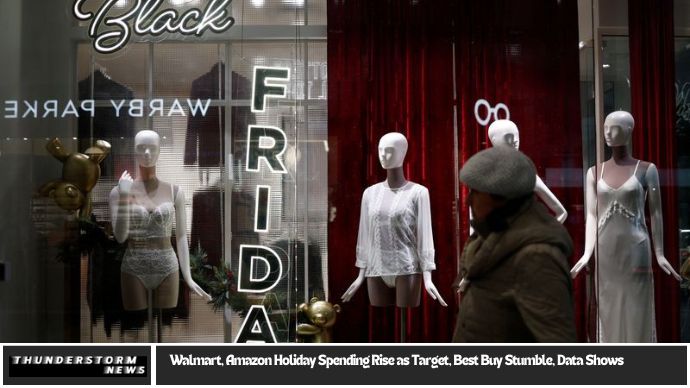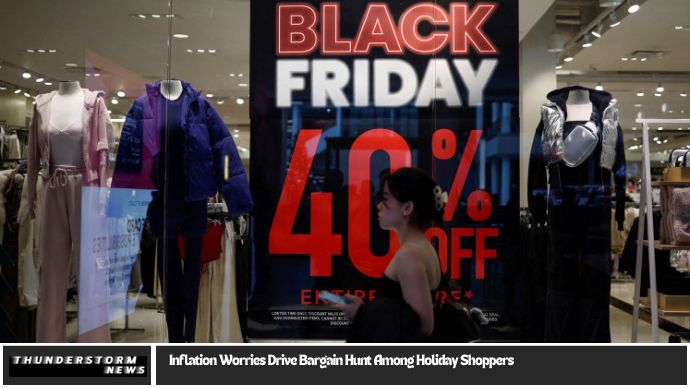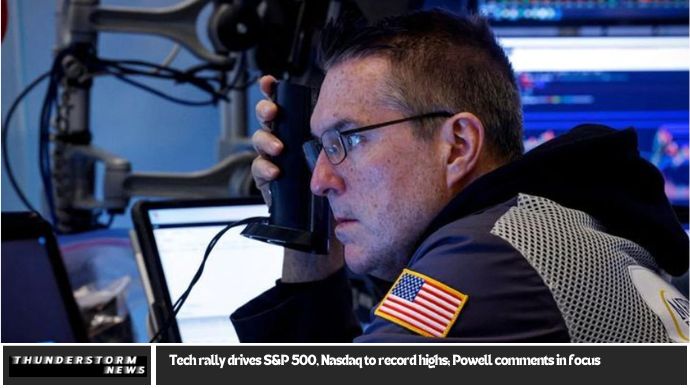The holiday season often brings out the best in retailers, with shoppers eager to score the best deals and businesses aiming to close the year on a high note. This year, however, the retail landscape has seen a few surprising twists. Data shows a significant rise in holiday spending for industry giants like Walmart and Amazon, while Target and Best Buy struggled to keep pace.
This trend raises some important questions: Why are Walmart and Amazon flourishing, while Target and Best Buy seem to be faltering? What do these shifts mean for consumers, retailers, and the broader retail market in 2024? Let’s dive into the data, trends, and insights to understand how the holiday season shaped up for these major retailers.
Walmart’s Success: What’s Behind the Boom?
Walmart, often a go-to retailer for everyday essentials, has been seeing impressive growth in its holiday sales. With a robust online presence paired with a vast network of physical stores, Walmart has been able to cater to the evolving shopping habits of consumers.
A major factor driving Walmart’s success is its seamless integration of e-commerce and in-store experiences. As more people shifted to online shopping, Walmart made significant strides in bolstering its digital offerings, including fast shipping, a wide array of products, and an easy-to-use app. This strategy allowed Walmart to capture a larger share of the holiday shopping pie, satisfying both traditional shoppers and those looking for convenience.
Beyond that, Walmart’s value-oriented pricing model continues to attract budget-conscious shoppers. With inflation still on consumers’ minds, Walmart’s ability to offer competitive pricing, discounts, and value bundles has resonated strongly. For families looking to stretch their dollars, Walmart remains a reliable option, especially during the holiday season.
Amazon’s Holiday Spending Surge: E-commerce Dominance Continues
Amazon, the undisputed e-commerce giant, saw a rise in holiday spending that further solidified its dominance in the online shopping space. Consumers flocked to Amazon in droves, taking advantage of early holiday sales, quick deliveries, and the convenience of shopping from home.
One key factor contributing to Amazon’s holiday success is its Prime membership. With access to exclusive deals, free shipping, and a curated shopping experience, Prime members are more likely to make Amazon their go-to destination. Furthermore, Amazon’s investment in its technology infrastructure, including AI-driven recommendations and voice-activated shopping through Alexa, has created a personalized and seamless shopping experience for millions of consumers.
Amazon also benefited from its massive product range, which caters to every need imaginable. Whether consumers were shopping for gadgets, home goods, or toys, Amazon provided an easy, one-stop solution. As shoppers increasingly look for convenience and speed, Amazon’s vast network of fulfillment centers and its advanced logistics system allowed it to deliver products quickly, keeping customers satisfied during the busy holiday period.
Target’s Struggles: What Went Wrong?
While Walmart and Amazon experienced success, Target found itself facing challenges during the holiday shopping season. Despite its reputation as a beloved brand offering stylish, affordable products, Target couldn’t match the spending rise of its competitors.
One reason for Target’s struggle may be related to its product mix. While the retailer offers trendy and seasonal items, many of its core offerings are often less essential than those sold by Walmart or Amazon. When shoppers feel financially stretched, they may gravitate toward more practical purchases, such as groceries or home essentials. In this regard, Walmart’s diverse product offerings may have had a stronger appeal during a time of financial uncertainty.
Target also faced issues with inventory management, which may have hindered its ability to meet consumer demand during peak shopping times. Despite a strong marketing campaign and efforts to attract shoppers with exclusive deals, Target wasn’t able to fully capitalize on the holiday season.
Best Buy’s Challenges: Supply Chain Woes
Best Buy, a leader in consumer electronics, also struggled this holiday season. While electronics are traditionally hot-ticket items during the holidays, Best Buy couldn’t quite keep up with the surges in demand that both Walmart and Amazon experienced.
One of the main issues Best Buy faced was supply chain disruptions. While many retailers battled this challenge, Best Buy, heavily reliant on electronics and tech gadgets, found it harder to manage the influx of demand. Additionally, the retailer struggled to keep stock of popular items, leaving consumers frustrated.
Best Buy’s holiday performance was also impacted by rising competition from online marketplaces like Amazon, which made it easier for consumers to find the same products from different sellers. While Best Buy offered deals on electronics, Amazon’s vast selection, coupled with fast delivery and often lower prices, made it the go-to destination for many holiday shoppers.
Data Insights: What Consumers Are Really Spending On
The holiday season of 2023 saw a shift in consumer spending patterns, as evidenced by the performance of Walmart, Amazon, Target, and Best Buy. While Walmart and Amazon enjoyed increased holiday spending, Target and Best Buy faced setbacks.
Consumer priorities have evolved. More shoppers have embraced online shopping for convenience, leading to a rise in e-commerce spending. Additionally, consumers are increasingly drawn to value-driven options, especially given ongoing inflation. Walmart’s ability to offer a combination of competitive pricing, quick shipping, and a seamless shopping experience helped it capture the hearts—and wallets—of budget-conscious shoppers.
Amazon also benefited from the trend toward online shopping, with its vast product selection and Prime membership perks. As more consumers prioritize convenience and speed, retailers that can deliver on these fronts are reaping the rewards.
The Future of Retail: What This Means for 2024
Looking ahead, the performance of Walmart, Amazon, Target, and Best Buy provides critical insights into the future of retail. As consumer behaviors continue to shift toward online shopping, traditional brick-and-mortar stores will need to adapt. Walmart’s success lies in its ability to blend the convenience of e-commerce with the physical store experience, while Amazon’s continued dominance is a testament to the growing power of online retail.
For retailers like Target and Best Buy, staying relevant in 2024 will require significant investment in e-commerce infrastructure, inventory management, and competitive pricing. The competition is only getting fiercer, and those who can offer a personalized, convenient, and value-driven shopping experience will be better positioned to thrive.
May you also like it:
Amazon Reportedly Working on Echo Frames for Delivery Drivers
Elon Musk Says It’s ‘Pointless’ to Build a Human-Driven $25,000 Tesla
Simplifying Crypto: Take Ownership of Your Financial Future with Crypto ki…
FAQ
1. Why did Walmart see a rise in holiday spending?
Walmart’s combination of affordable prices, a strong in-store and online presence, and competitive discounts helped it capture more holiday spending from budget-conscious shoppers.
2. How did Amazon perform this holiday season?
Amazon saw a significant increase in holiday spending, driven by its Prime membership, vast product selection, and personalized shopping experience.
3. Why did Target struggle this holiday season?
Target struggled due to its product mix and inventory management issues, which made it less competitive compared to Walmart and Amazon, especially during peak shopping periods.
4. What were Best Buy’s challenges during the holidays?
Best Buy faced supply chain disruptions, making it difficult to keep up with demand. Additionally, Amazon’s competitive pricing and fast shipping pulled shoppers away from Best Buy.
5. What can we expect from retail in 2024?
In 2024, retailers will need to focus on enhancing their e-commerce strategies, improving customer experience, and offering competitive pricing to stay ahead in an increasingly digital market.
6. How are consumer spending habits changing?
Consumers are prioritizing convenience, value, and online shopping. Retailers offering a seamless online experience combined with affordable prices will thrive in the changing retail landscape.
Conclusion
The holiday spending data for 2023 reveals a clear shift in consumer behavior. While Walmart and Amazon surged ahead with increased holiday spending, Target and Best Buy struggled to keep pace. The takeaway here is clear: consumers are prioritizing value, convenience, and a seamless shopping experience. As we move into 2024, retailers must adapt to these evolving trends if they wish to remain competitive. With e-commerce continuing to dominate, those who invest in online shopping solutions, quick delivery, and competitive pricing will be best positioned for success in the coming year.





